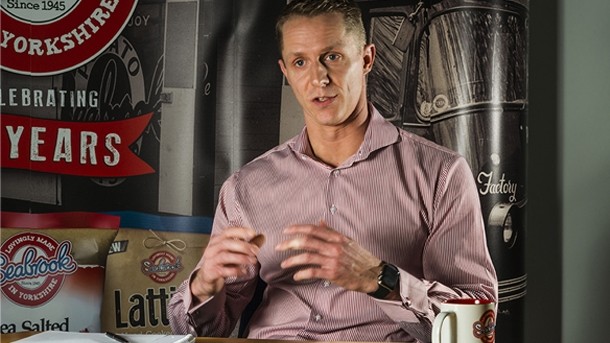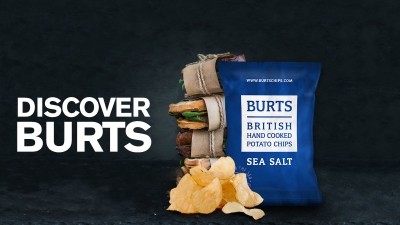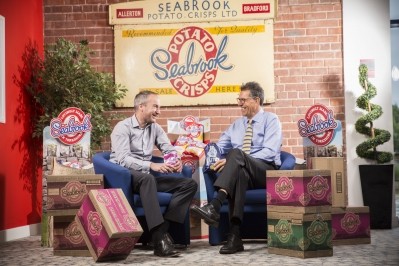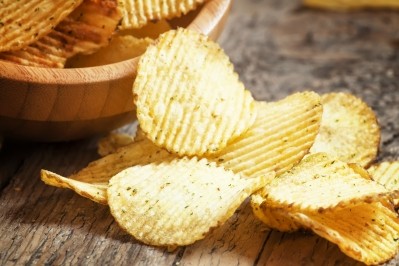Me and my factory
Seabrook Crisps boss explains firm’s revival

I joined Seabrook five years ago as part of the management team brought in to improve the business’s fortunes.
In my time here, we have evolved from a regional crinkle-cut crisp maker to a national supplier of branded and own-label varieties, adding £5M in turnover along the way.
My background is in finance, having trained as a chartered accountant at Ernst & Young in Leeds. From there, I became finance director at Zubrance – which owns a group of food businesses down the road in Harrogate – before moving to Seabrook.
Initially, I was appointed finance director, but through the changes we were making I very quickly saw an opportunity to get involved in the factory operations as well. Today, I am responsible for both areas.
The problems at Seabrook in 2012 are well-documented. Sales and profits were down, costs were escalating, and a full-scale turnaround was required.
We put together an investment plan to improve efficiency, and in July 2015 we secured the funds to bring that plan into life thanks to a management buyout by chief executive Jonathan Bye, supported by private equity firm LDC, which now owns a majority stake in the company.
The £4M was spent on making some very manual processes automated. It has allowed us to reduce labour costs by around 30%, without making any redundancies.
Instead, we’ve condensed the shift pattern from six to four nights a week, and we take on fewer agency staff. In all, we are now much more efficient.
Much more flexible (Back to top)
Investment has also made us much more flexible in regards to the type of products we can produce, and how quickly we can produce them.
Before, we could only run one product at a time. But now, we can run two fryers simultaneously, which feed into 19 different bagging lines.
The crisp market is extremely competitive and aggressive, and that flexibility is one of the things I think sets us apart from the bigger players.
Factory facts
LOCATION: Seabrook House, Duncombe Street, Bradford. BD8 9AJ
SIZE: 6,000m2
STAFF: 150
TURNOVER: £27M
MAIN PRODUCTS: Crinkle, lattice and straight-cut crisps.
CUSTOMERS: All main retailers, discount retailers and wholesalers.
PRODUCTION LINES: Two fryers, 19 bagging lines.
OUTPUT: 7,000t of potatoes a year.
We are prepared to operate in areas and in niches where perhaps our competitors aren’t, due to their scale. One good example of this is our lattice-cut crisps, which is essentially two crinkle-cuts overlaid at 90° angles.
The trough part of the lattice is very thin, and when you fry it out, it disintegrates and creates a hole. Making it is quite a slow process, but it has added about £3M of turnover. It’s been a nice little addition for us, but would be a drop in the ocean for the bigger players.
The changes have been welcomed by the staff as well. In all, I deal with about 10 people on a regular basis, and they are all fantastically self-motivated.
I have less day-to-day contact with staff on the shopfloor, but the journey I’ve been on with them has been no less significant.
Culture of distrust (Back to top)
When I joined, for whatever reason, there appeared to be a culture of distrust of management. Therefore, it was really important for those people to see me as someone who had the same goals as them.
I demonstrated that by doing the job they were doing and helping out on the shopfloor when we were busy. We also hold regular forum meetings, where staff are given an opportunity to talk about issues as they see them.
Having open information channels is important as well. We publish performance data on a daily and weekly basis, and have continuous improvement meetings twice a week.
This way, staff know exactly what the outputs of their lines are, against predetermined key-performance indicators. It’s another tactic to get staff interested in improving their factory, which I believe is paying off.
We have just started classroom-based training to enable staff to be confident in the machinery they are using. We have also started offering a number of qualifications, which have been backed by Bradford Council.
All staff work to assigned set skill levels, and we encourage them to gain the necessary qualifications to make the next step – because that’s what ultimately drives success within the factory.
However, it’s important to recognise that some people are content with remaining at the level they are at, so we don’t try to force people to do something they don’t want to.
Better factory than five years ago (Back to top)
Overall, I believe we have a materially better factory than five years ago. We are producing a substantially better product, our costs are down, and we recently received British Retail Consortium Grade AA accreditation.
In the year ahead, we will be working to make sure we get the best out of the investments made in 2016. It’s an unfortunate truth that automation projects never go 100% right the first time, and we are no exception to that rule.
Next year will likely involve a different investment profile and a capability extension. Those plans are ongoing, so it’s not something I can go into too much detail about, but we’ve got plenty of room on this site and only work nine shifts out of a possible 14.
The bagged snacks market continues to grow – and is now marginally bigger than the crisps market – so snacks are something we will get to look into in the foreseeable future.
Another growing market is own-label. Before the buyout in 2015 we were 100% branded, but we now have a number of own-label contracts, and it is logical to pursue more.
The crisps market is a tough one to be in, and we’re up against some phenomenal world-class brands, but I feel our company can now compete with the best of them.
Meanwhile, find out more about how the chief operating officer managed to win over the trust of the shop floor staff at Seabrook in our exclusive video interview.
Personal
NAME: Daniel Woodwards
AGE: 39
DOMESTICS: Engaged
OUTSIDE WORK: I don’t play football any more, but I still love going to the gym so that’s become my main passion. I also enjoy skiing.
GREATEST ACHIEVEMENT: Being a part of the operational and cultural turnaround at Seabrook. When I first joined, there was an atmosphere of distrust between staff and management. Now, I like to think they see me as someone on their side.
ADVICE TO YOUNGER SELF: Trust in your own ability. I never trained to work in operations, so there was always a niggling doubt that making the move was the right thing to do. However, I think as a team, we’ve done a great job.















